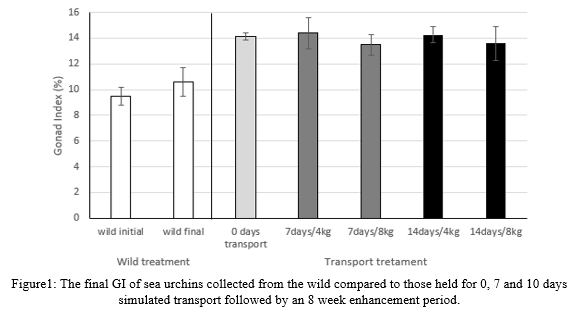IMPACT OF TRANSPORT ON SUBSEQUENT ROE ENHANCEMENT OF THE SEA URCHINS Stronylocentrotus droebachiensis AND Paracentrotus lividus
Introduction
There is growing interest in Europe and worldwide in the capture and roe enhancement of various sea urchin species. There has been a significant amount of research focused on feed development and protocols for sea urchin roe enhancement. Less focus has been directed on the protocols for, and the impact of, transport on subsequent survival, and roe enhancement of sea urchins. This is a crucial step in the value chain as sea urchins need to be transported from the point of harvest to enhancement facilities as well as onwards to markets (sometimes via live holding hubs). This study describes some of the research being undertaken to understand what the stressors are for sea urchins during transport, particularly when this is followed by roe enhancement.
Materials and methods
A series of experiments were run to determine the optimal transport methods for Strongylocentrotus droebachiensis, in terms of both ‘in water’ (road and sea) and ‘out of water’ (road and air) transportation. This presentation will focus on a simulated transport trial followed by a roe enhancement trial to measure the effect of transport stress on subsequent roe enhancement. Sea urchins were held in simulated transport (static seawater tanks with aeration) for 0 days, 7 days and 14 days at 2 different densities. They were then transferred to a roe enhancement system and enhanced for 8 weeks. At the conclusion of that period the increase in sea urchin gonad index (GI) and the biochemical quality of the roe was measured. Additional trials have been conducted on Paracentrotus lividus to see how they compare in terms of sensitivity to transport stress. This presentation will focus on the former species but will discuss possible implications for the latter.
Results and Discussion
Overall, sea urchins held in simulated transport (static seawater tanks with aeration) for 0 days, 7 days and 14 days showed no significant differences in GI after the enhancement period (Figure 1) . There was also no significant difference in the final GI of sea urchins held at low (4kg) or high (8kg) densities during the transport or between sea urchins transported for 7 days or for 14 days prior to enhancement (Figure 1).
.
However, there were differences in sea urchin mortality between sea urchins transported 0 days vs all simulated transport treatments. There was also higher mortality in sea urchins transported for 14 days compared to 7 days (Table 1). The biochemical results will also be presented (not yet available).
Preliminary testing on P. lividus suggest this species is much more sensitive to transport stress than S. droebachiensis . All the results from this and a series of studies will be discussed in terms of the future development of a sea urchin roe enhancement industry and what role transport plays in this.

